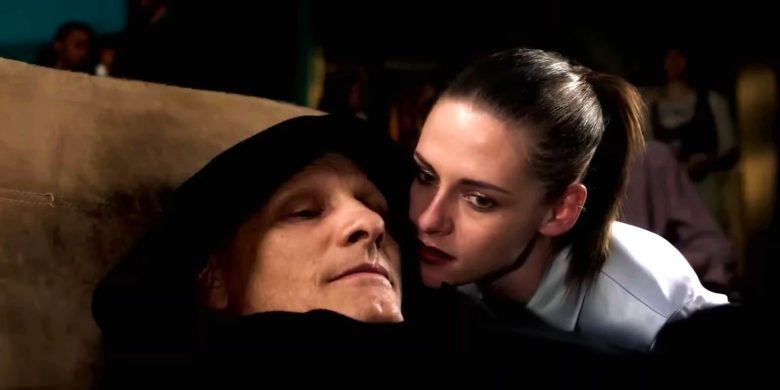REVIEW by ERIC LINDBOM – In any gore hound’s game of word association, “body horror” spells Canadian director (and oft screenwriter) David Cronenberg back after eight years with the delectable fascination Crimes of the Future (in theaters).
Cronenberg was last heard from with the unjustly ignored Maps of the Stars (a potent Hollywood back stab where Julianne Moore as a haughty celeb got bludgeoned to death with an acting award and, in a morbid irony, went on to win a non-weaponized Golden Globe statuette for the performance!).
His hermetically sealed comeback (shot in Greece) from a script he penned twenty years’ ago takes place in an eco-ravaged world where physical pain has been erased. Therefore, thrill seekers search for ouch and find it voyeuristically through a performance art team. The body of Saul Tenser (Viggo Mortensen) sprouts mutating, toxic organs. His besotted art partner (a feverishly committed Lea Seydoux) removes them surgically like a gardener in front of adoring night club-styled crowds clutching cameras.
Their act worries a government agency that registers new organs. No DEVO fans, the bureaucrats worry “human evolution is going wrong.” One of them (an uncharacteristically hilarious and staccato Kristen Stewart) gets turned on by Tenser and declares “surgery is the new sex.”
That line thematically links to Cronenberg’s kinkier Crash and the far more realized Crimes often plays like a Cronenberg Greatest Hits LP. The many bodily incisions echo Videodrome’s “New Flesh,” the spindly chair that helps Saul’s painful digestion recalls Naked Lunch and the surgical tool visually reminds us of the AI controller from eXistenZ.
While Cronenberg has a reputation among some myopic observers as being clinical and icy, actors adore working with him. I’ll never forget Jeremy Irons accepting his Best Actor Oscar for his Claus von Bulow performance in Reversal of Fortune and thanking his Dead Ringers director Cronenberg.
Happy customer Mortensen returns for his fourth collaboration (after A History of Violence, Eastern Promises, A Dangerous Method). Garbed in a black Ninja cloak, it’s a physical performance as he battles nausea while croaking about new projects cooking in his guts. The removal of same though sensuous vivisection is not for the easily grossed out.
Horror and sci-fi fans rightly admire Cronenberg as an idea not shock driven auteur. Crimes references our decaying earth through a subplot with eco terrorists who feast on plastic; hopefully, that prophecy will come true and save marine life from strangulation. Tangy wit abounds as well particularly jabs at masochistic performance artists and facile detractors of modern art. One skeptic disses Tenser as “a glorified organ donor.”
Consistently startling with an ingeniously rendered world, Crimes benefits from a piercing electro soundtrack from composer Howard Shore, his 16th score for Cronenberg.
Crimes easily fills a niche as a career summation. Fortunately, Cronenberg isn’t through with us just yet. He’s currently retrofitting his rejected Netflix series into The Shrouds, a self-scripted film with Vincent Cassel discovering a path to contacting the deceased.
Body Horror Homework (Cronenberg’s Early Years):
Shivers (or They Came From Within) (1975): Leech-like parasites spread VD in a high rise. Key shock: Horror icon Barbara Steele in the bathtub.
Rabid (1977) Plastic surgery goes way wrong for motorcycle accident victim (Beyond the Green Door porn star Marilyn chambers) who spreads foam mouthed rabies across town. Key shock: Her blood extracting orifice under her arm pit that no deodorant roll-on can mask.
The Brood (1979): Oliver Reed believes neuroses can manifest themselves physically – in this case as murderous midgets. Key shock: “Samantha Eggar eats her after birth” huffed a dismayed critic in Leonard Maltin’s Movie Guide.
Scanners (1981): Telepaths with mad powers go underground. Cronenberg’s most accessible, popular, and least intriguing early work. Key shock: Exploding heads galore.
Videodrome (1983): James Woods stumbles on cable transmissions he watches at his own risk. Key Shock: Woods inserts a VHS tape into his own halved belly.
The Dead Zone (1983): While Stephen King famously hated Stanley Kubrick’s The Shining, the author preferred Brian De Palma’s Carrie to his book. He also adored Cronenberg’s straight ahead take on this episodic novel with Christopher Walken in a rare leading man role. Key shock: Martin Sheen’s deranged President, finger on the nuke button.
The Fly (1986): A scientist accidentally gets genetically joined with a buzzing pest. Like the ever admired/parodied ending of Soylent Green, the 1958 version of The Fly lingers due to the final image of David Hedison squeaking “help me,” his human head on a fly body about to be chomped by a spider. Tough act to follow but Cronenberg’s The Fly takes wing with Jeff Goldblum’s wrenching performance as Brundlefly aided by Oscar-winning make up. An allegory for the AIDS epidemic and, for my ticket-buying money, the finest film on this list.







